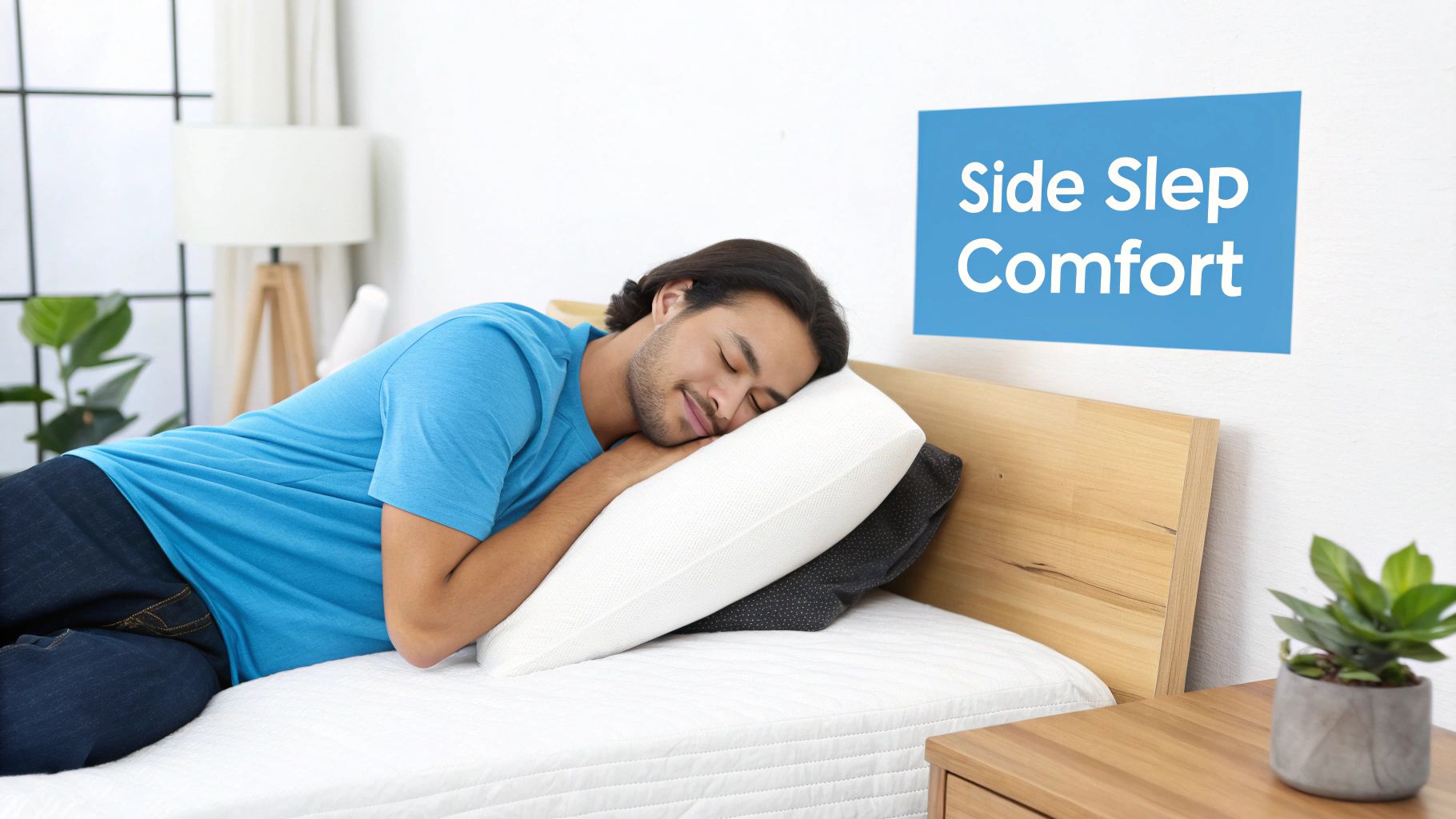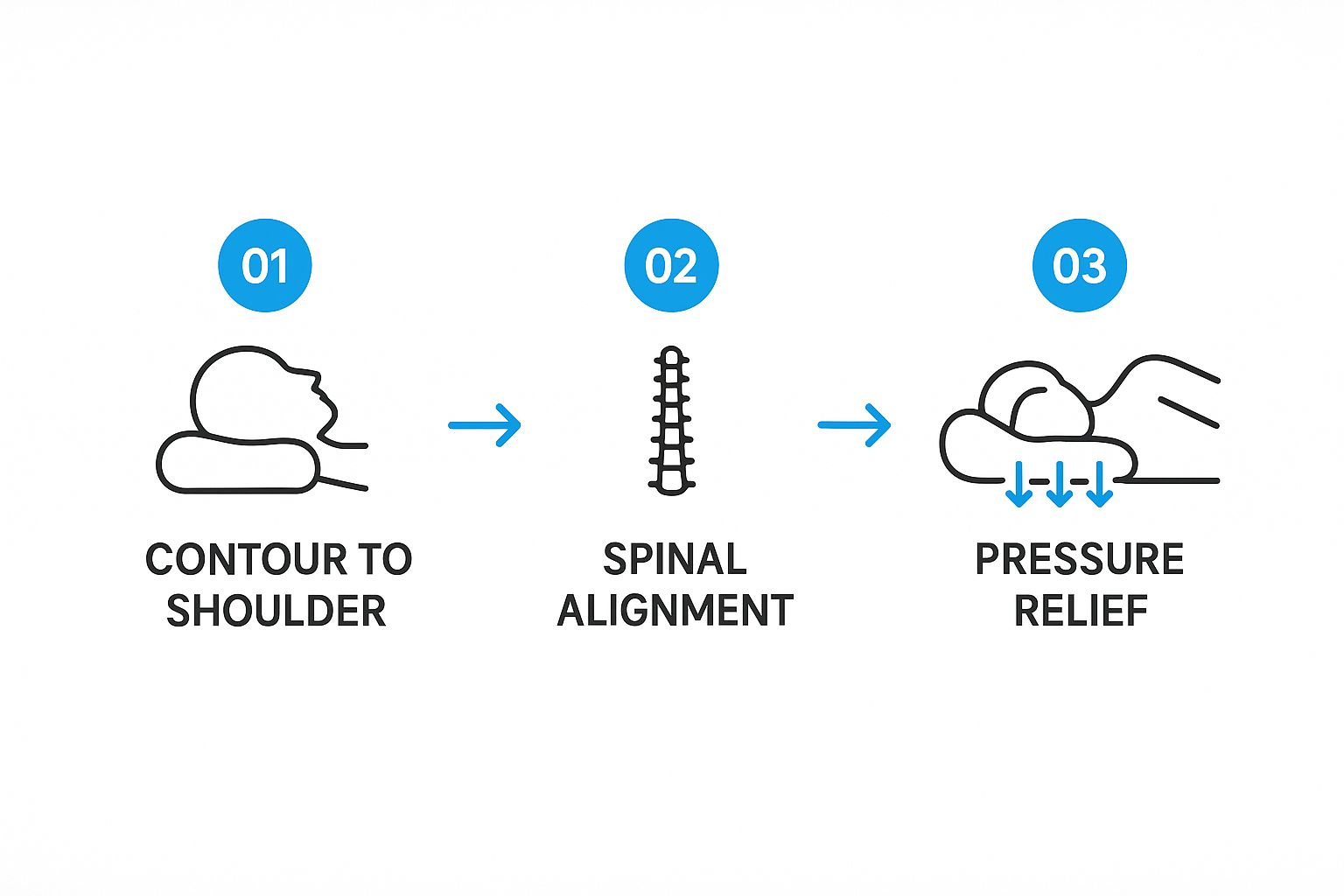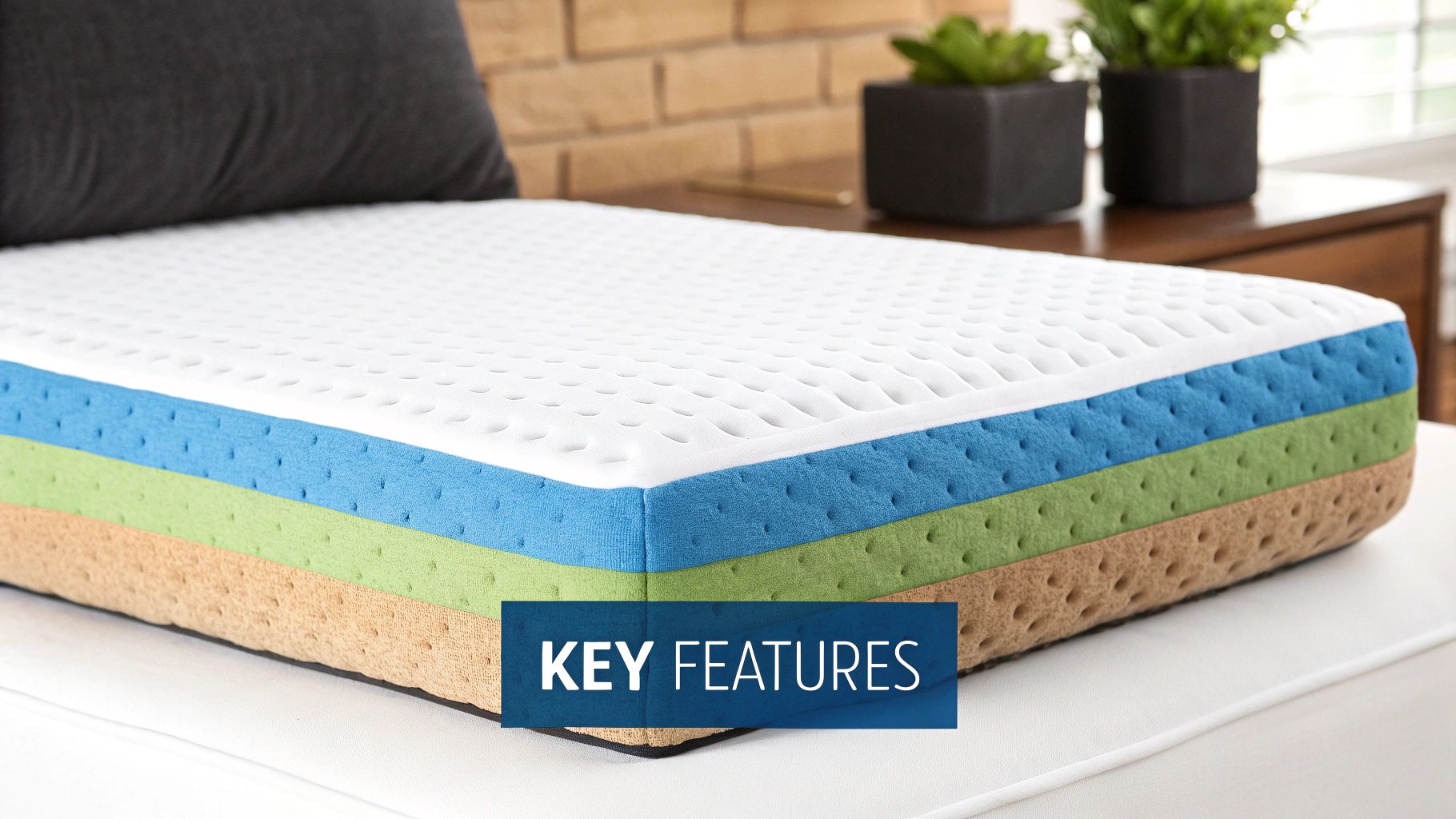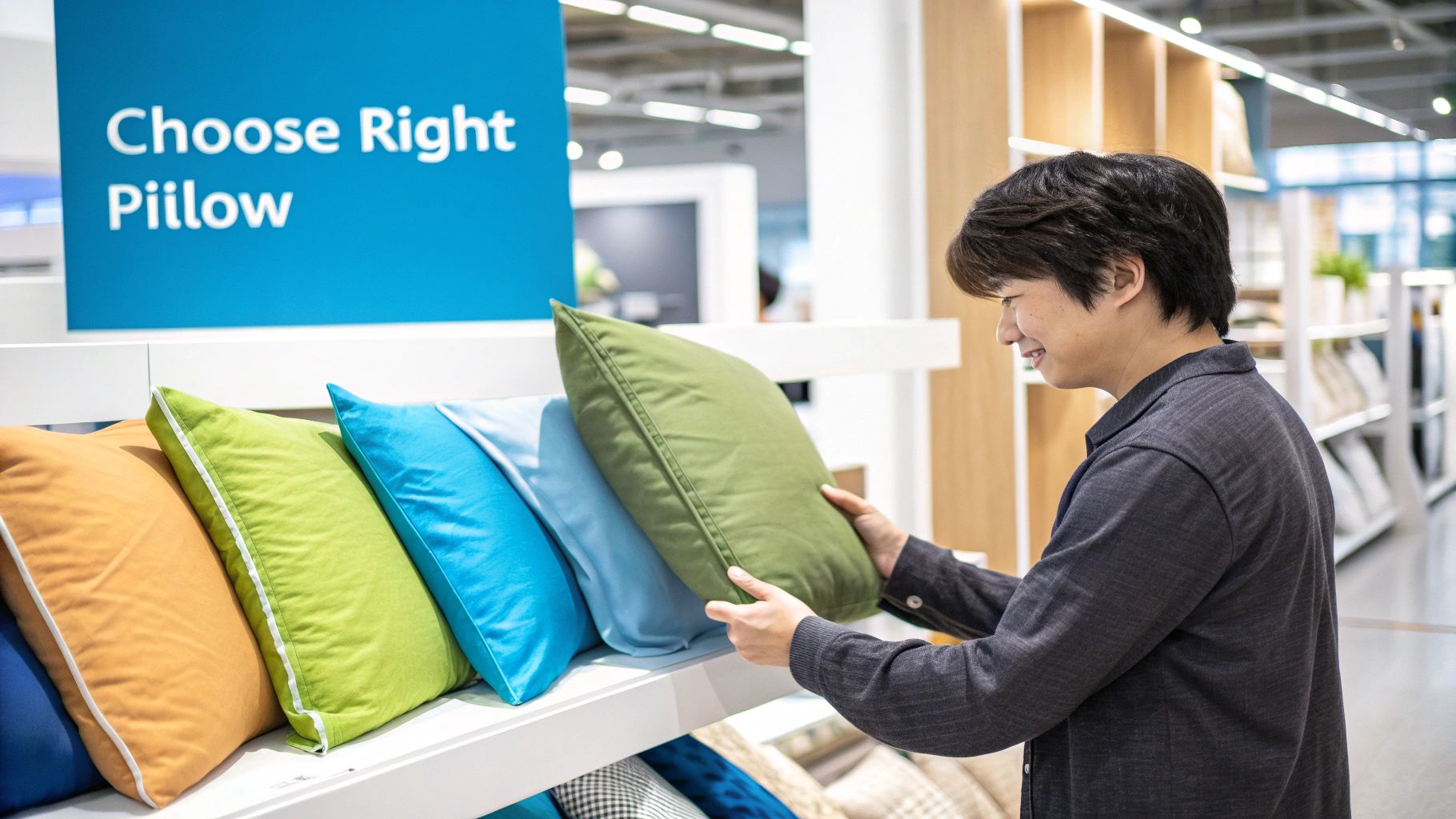For side sleepers, the magic formula is usually a high-loft pillow (think 4-7 inches thick) with a medium to firm feel. This specific combination is the key to filling that gap between your head and the mattress, keeping your spine perfectly straight while you sleep.
Why Side Sleepers Have Unique Pillow Needs
If you're a side sleeper who regularly wakes up with a stiff neck or an aching shoulder, you're not alone. The problem almost always comes down to poor spinal alignment, and the culprit is usually your pillow.
Unlike folks who sleep on their back or stomach, side sleepers have a pretty significant space between their head and the mattress. If that gap isn't properly filled, your neck is forced into an awkward, bent position all night. A good memory foam pillow isn't just a comfortable accessory; for a side sleeper, it's a non-negotiable tool for getting truly restorative sleep.
This guide will help you zero in on what actually matters when you're on the hunt for the perfect pillow. We’ll get into why your sleeping position demands special support and how the right choice can turn your painful mornings into pleasant ones.

What to Look for in a Side Sleeper Pillow
To find your perfect match, you need to focus on a few critical features. Get these right, and you're well on your way.
- High Loft: Aim for a pillow that's between 4 and 7 inches thick. This height is crucial for bridging the gap created by your shoulder and properly supporting your head and neck.
- Medium-Firm Density: You want a pillow that's firm enough to hold your head up, preventing it from sinking down during the night. At the same time, it needs to be soft enough to cushion and relieve pressure points.
- Supportive Shape: While a traditional rectangular pillow can work, many side sleepers find that contoured or gusseted designs offer far better ergonomic support. That little curve for your neck can make a huge difference.
A huge mistake I see people make is grabbing a pillow that’s way too soft. It feels amazing for the first five minutes, but it quickly compresses under the weight of your head, leaving your spine completely out of alignment by morning. The goal is consistent support throughout the night, not just a fluffy first impression.
Understanding the core memory foam pillow benefits can offer a deeper look into why this material is so well-suited for the job.
It's also worth remembering that your pillow is just one piece of the sleep puzzle. Creating a holistic sleep hygiene routine is just as important. For instance, managing your light exposure before bed can have a massive impact. It’s worth exploring the benefits of blue light glasses for improving rest and sleep quality as another tool to upgrade your nightly rest.
Side Sleeper's Pillow Checklist
Feeling a bit overwhelmed? I get it. Here’s a quick-glance table to keep the most important features top-of-mind while you're shopping. It breaks down exactly what to look for and why it's so important for sleeping on your side.
| Feature | What to Look For | Why It Matters for Side Sleepers |
|---|---|---|
| Loft (Height) | 4 to 7 inches | Fills the space between your head and shoulder, preventing neck strain. |
| Firmness | Medium to Firm | Prevents your head from sinking and ensures consistent spinal alignment. |
| Shape | Contoured or Gusseted | Provides targeted ergonomic support for the natural curve of your neck. |
| Material | High-Density Memory Foam | Offers a balance of contouring comfort and durable, long-lasting support. |
| Cover | Breathable & Washable | Promotes airflow to keep you cool and allows for easy cleaning. |
Think of this checklist as your secret weapon. If a pillow ticks all these boxes, you're very likely looking at a great candidate for your next best night's sleep.
Finding Your Ideal Loft and Firmness
For side sleepers, two things matter more than anything else when picking a pillow: loft and firmness. Getting this combo right is the difference between waking up feeling great and starting your day with that all-too-familiar kink in your neck.
Think of it this way: your pillow’s only job is to fill the gap between your head and the mattress, keeping your spine in a perfectly straight line from your neck down your back. Simple, right?
If the loft (the pillow's height) is too low, your head will sag downwards. Too high, and it gets pushed up at an awkward angle. Both scenarios throw your alignment out of whack and cause strain. For most of us who sleep on our side, the sweet spot for loft is somewhere between 4 and 7 inches. This range usually does a great job of matching the width of a person's shoulder.
How to Measure for the Right Loft
You can actually get a pretty solid idea of your ideal loft without leaving your house.
Just stand facing a wall, then turn your head to the side and lean it against the wall like you would on a pillow. Now, have someone measure the distance from your ear to the outer edge of your shoulder. That number is a fantastic starting point for the pillow height you should be looking for.
Firmness is the other half of the equation. A super-soft pillow might feel nice for a minute, but it will almost certainly collapse under the weight of your head during the night. A high loft means nothing if the pillow goes flat.
On the flip side, a rock-hard pillow can create painful pressure points on your ear and jaw. This is why a medium to medium-firm memory foam pillow is almost always the best bet for side sleepers. It’s strong enough to keep your head propped up but still has enough give to contour comfortably to your head and neck.
This infographic breaks down exactly how the right memory foam pillow supports a side sleeper.

As you can see, it starts by conforming to your specific shape. That contouring leads directly to proper spinal alignment, which is what ultimately relieves that nagging pressure.
The Power of Adjustability
Let's be real—finding the "perfect" loft and firmness straight out of the box is tough. That’s exactly why adjustable pillows have become so popular.
These pillows let you add or remove the fill, putting you in complete control. If you're someone who constantly battles neck pain, getting a pillow you can customize can be a total game-changer. You can dig deeper into how an adjustable pillow for neck pain can provide that personalized support.
A little pro-tip from my own experience: start with a pillow that feels slightly higher than you think you need. Sleep on it for a couple of nights. If you feel any strain, just remove a small handful of the fill. It’s way easier to dial in the perfect height by taking fill out than to realize you don't have enough to begin with.
Side sleepers make up a huge portion of the market for memory foam pillows precisely because that support is so critical for us. The experts agree: the best pillows for side sleepers often feature adjustable lofts and a medium-firm feel.
Just look at some of the top-rated options for 2025. The Luxome LAYR Pillow has a massive 9.5-inch adjustable loft, and the Brooklinen Marlow Pillow offers a 5-inch adjustable height. Both were designed specifically to fight neck pain and shoulder pressure for people who sleep on their sides.
Diving Into the Different Types of Memory Foam

Stepping into the world of memory foam can feel a bit like ordering a specialty coffee. What seems straightforward at first—"I'll take a memory foam pillow"—is actually full of different varieties, each with its own unique feel and benefits.
And trust me, for a side sleeper, these differences aren't just minor details. They're everything.
The type of foam you pick will directly affect the pillow's support, breathability, and whether or not you can even adjust it. To find the right fit, you need to know the big three: solid, shredded, and gel-infused foam.
The Old-School Classic: Solid Memory Foam
This is the pillow most of us picture when we hear "memory foam." It’s a single, solid block of foam, often contoured with a specific curve to cradle your neck. Its main selling point is that it offers unwavering, consistent support. The foam isn't going anywhere, so it won't shift or clump up in the middle of the night.
But that strength is also its biggest weakness. The loft and firmness are set in stone. You can't change a thing. And for anyone who sleeps even a little bit warm, solid foam is infamous for trapping body heat.
The Side Sleeper's Secret Weapon: Shredded Memory Foam
Here’s where things get really good for side sleepers. Instead of one solid chunk, these pillows are packed with thousands of tiny pieces of memory foam. This simple change introduces one game-changing feature: adjustability.
Most shredded memory foam pillows come with a zippered cover. This means you can actually open it up and add or remove handfuls of the fill to get the exact loft you need. This is a massive win for side sleepers, letting you dial in the pillow's height to perfectly fill that gap between your head and the mattress.
Beyond customization, the shredded design is a huge improvement for airflow. All those little gaps between the foam pieces let air move freely, making it a much cooler sleep than its solid cousin.
The ability to adjust your pillow's loft is more than a convenience; it's a fundamental part of achieving proper spinal alignment. A pillow that's perfect for a broad-shouldered person will be far too high for someone with a smaller frame, and shredded foam solves this problem beautifully.
Years of expert testing back this up. In fact, recent 2025 consumer reports found that adjustable pillows with shredded memory foam fillings provided far better support across different body types, keeping the spine aligned. While some models could still get a bit warm, they massively outperformed solid foam on breathability. You can read the full test results on Consumer Reports to see how they stacked up over time.
The Cool Crowd: Gel-Infused and Aerated Designs
Manufacturers know that memory foam has a reputation for sleeping hot, so they’ve come up with some clever ways to tackle the heat. Gel-infused foam is one of the most common solutions.
During production, tiny cooling gel beads or swirls of liquid gel are mixed right into the foam. This gel works to pull heat away from your head and neck, helping you stay at a more comfortable temperature all night.
You’ll also run into pillows with aerated designs. This is a fancy way of saying they have small holes or channels running through the foam. It’s a simple but effective trick that dramatically improves ventilation, letting hot air escape and cool air circulate. The best memory foam pillows for side sleepers often combine a shredded design with gel-infusion to give you the best of all worlds: personalized support, adjustability, and a cooler night's sleep.
Key Features to Look For Beyond the Foam
You've nailed down the loft, firmness, and type of memory foam you need. That’s the hard part done. But the details are what separate a good pillow from a great one.
Think of it like this: the foam is the main event, but the pillow's shape, its cover, and the materials used are the supporting cast. They play a huge role in your overall comfort, health, and how long your new pillow will last. Let's dig into these final, crucial details.
Pillow Shape and Your Sleep Style
Memory foam pillows typically show up in two main shapes: the one we all recognize, and a curvier, more ergonomic version.
A traditional pillow shape is that classic rectangle you’ve slept on your whole life. Its biggest advantage is its simplicity. It just works. It feels familiar and makes it easy to shift around during the night without a second thought.
Then you have the ergonomic or contoured pillow. This one has a distinct wave-like design with a dip in the middle. That curve isn't just for looks; it’s specifically engineered to cradle your head and support the natural curve of your neck. For side sleepers who are constantly battling neck pain, this shape can be a complete game-changer, as it does a much better job of promoting proper spinal alignment.
My personal take? If you're generally sleeping well and just looking for an upgrade, the traditional shape is a solid, no-risk choice. But if you're actively trying to fix nagging neck pain, a contoured design is absolutely worth a shot. It might feel a little odd for the first night or two, but that targeted support is often exactly what a side sleeper’s neck has been crying out for.
The Importance of a Quality Cover
That fabric cover wrapped around the foam? It’s way more than just a protective layer. It has a direct impact on how breathable the pillow is, how clean it stays, and how it feels against your skin.
A cheap, low-quality cover can completely ruin the experience by trapping heat and moisture, making any cooling gel infusions in the foam pretty much useless.
You want a cover made from materials known for being cool and wicking away sweat.
- Bamboo-derived fabrics: These are incredibly soft, naturally hypoallergenic, and do an amazing job of pulling heat away from your head and neck.
- Organic Cotton: A tried-and-true classic. It's breathable, durable, and you don't have to worry about the harsh chemicals used in a lot of conventional cotton farming.
- Tencel™: If you want something that feels silky-smooth and is fantastic at regulating temperature, Tencel™ is a premium choice that seriously ups the comfort factor.
Also, a removable and machine-washable cover is non-negotiable. This is critical for keeping your pillow fresh and free from allergens like dust mites and bacteria. Being able to toss the cover in the wash is the single best way to extend the life of your pillow. For a deeper dive, our guide on pillows that keep you cool gets into even more detail on these materials.
Look for Health and Safety Certifications
Last but definitely not least, flip the pillow over and check for safety certifications. The big one you want to see is CertiPUR-US®.
This certification is your guarantee that the foam was made without a bunch of nasty stuff: ozone depleters, heavy metals like mercury and lead, formaldehyde, or certain harmful phthalates. It also ensures low VOC (Volatile Organic Compound) emissions, which is better for your home's air quality.
Seeing that CertiPUR-US® seal gives you peace of mind that you're resting your head on something that's safe for you and better for the planet.
How to Choose with Confidence

Alright, you've done the hard work. You've wrapped your head around loft, firmness, and the different kinds of memory foam. Now comes the moment of truth: picking one without that nagging fear of buyer's remorse.
Good news. The pillow market is fiercely competitive, and that's a huge advantage for you. To stand out, many brands now offer incredibly consumer-friendly policies. You just have to know what to look for.
This is where you need to tune out the marketing buzz and focus on the guarantees. Your golden ticket to making the right choice? A generous sleep trial.
A sleep trial is your chance to test a pillow in the real world—in your own bed, on your specific mattress, for weeks at a time. Lying on a pillow for two minutes in a brightly lit store tells you almost nothing. You need to feel how it performs night after night as the foam settles and your body adjusts.
These trials can range from 30 nights all the way up to a full year. Honestly, this is the most powerful tool you have for finding the best memory foam pillows for side sleepers.
Decoding Sleep Trials and Warranties
Think of a sleep trial as a risk-free test drive. If the pillow isn’t quite right—maybe it’s a tad too firm, or the loft doesn't perfectly fill that gap—you can send it back for a full refund. A company willing to offer this is a company that's confident in its product.
Beyond the trial, the warranty tells you a story about the pillow's long-term durability.
- What it covers: A solid warranty protects against manufacturing defects. We're talking about foam that cracks or splits prematurely, or significant sagging that goes beyond normal wear and tear.
- What it doesn't cover: Warranties usually won't cover the gradual change in softness that all foam experiences over time, or, of course, any damage you cause yourself.
A 3- to 5-year warranty is a great sign. It tells you the manufacturer has used quality, durable materials designed to hold their shape and support for years, not just a few months.
This industry-wide confidence isn't happening in a vacuum. The global memory foam pillow market hit USD 2.87 billion in 2024 and is on track to nearly double by 2033. This growth is fueled by people just like you, searching for better support and pain relief, which in turn pushes brands to offer better products and better policies.
While the perfect pillow is a massive step, remember it's just one part of your overall sleep setup. For a deeper dive into creating the ideal foundation for your rest, learning how to choose the right mattress is just as important. By prioritizing a strong sleep trial and a solid warranty, you can invest in your sleep health with total peace of mind.
Putting Your Final Questions to Rest
Even when you think you've found the one, a few last-minute questions can pop up. That's completely normal. Picking the right pillow feels like a big commitment to your sleep health, so let's clear up those final bits of uncertainty.
Think of this as your final check-in before you can confidently click "buy" and get on the road to better sleep.
How Long Does a Memory Foam Pillow Last?
A high-quality memory foam pillow is an investment, and you should expect it to hold up for a good while. Generally, a well-made pillow will give you solid, consistent support for 2 to 3 years. After that, you'll find the foam starts to break down and lose its magical supportive properties, which is when that all-too-familiar morning neck pain creeps back in.
So, how do you know it's time to say goodbye? Look for these tell-tale signs:
- It Remembers Too Well: If your pillow is holding onto the impression of your head long after you've gotten up, it’s lost its ability to spring back. That means its support structure is shot.
- It's Getting Lumpy: This is especially true for shredded memory foam. If you can't fluff it back into a smooth, even surface anymore, the fill has broken down.
- The Pain Returns: The most obvious sign of all. If you start waking up with the same neck and shoulder aches you were trying to escape, your pillow is no longer doing its job of keeping your spine aligned.
Here's a quick pro tip: Fold your memory foam pillow in half. If it doesn't immediately snap back to its original shape, its resilience is gone. Time to start shopping.
Can a New Pillow Cause Neck Pain at First?
Yes, and it's more common than you'd think. When you switch to a new pillow—especially if your old one was flatter than a pancake—there's going to be an adjustment period. Your neck and shoulder muscles have grown accustomed to being in a less-than-ideal position. Forcing them back into proper alignment can feel a little weird or even uncomfortable for the first few nights.
This break-in phase usually lasts anywhere from a few days to about a week. If the pain is sharp, or if it's still bugging you after two weeks, that's a red flag. It likely means the pillow has the wrong loft or firmness for your body. This is exactly why sleep trials are a non-negotiable feature; they give you a risk-free window to make sure the pillow is a perfect match.
How Do I Properly Clean My Memory Foam Pillow?
Good hygiene is key to making your pillow last and keeping your sleeping environment healthy. But listen up, because this is important: never, ever put a solid memory foam pillow in the washing machine or dryer. The aggressive spinning and high heat will absolutely destroy the foam's delicate structure.
Instead, follow these simple steps to keep it fresh:
- Wash the Cover Regularly: Most memory foam pillows come with a removable cover that you can toss in the wash. Treat it like your other bedding and wash it every couple of weeks.
- Spot Clean the Foam: If you have a spill, mix a bit of mild detergent with water. Gently dab the stain with a clean cloth. The key word here is dab—don't scrub it like you're trying to get a stain out of concrete.
- Let It Air Dry: After spot cleaning, let the pillow air dry completely in a spot with good circulation before you put the cover back on. To freshen it up between washes, you can sprinkle the foam with baking soda, let it sit for an hour, and then vacuum it up using a hose attachment.
Frequently Asked Questions
Still have a few things on your mind? We've gathered some of the most common questions side sleepers ask when they're on the hunt for the perfect memory foam pillow.
| Question | Answer |
|---|---|
| What is the best pillow loft for side sleepers? | A medium to high loft (5-7 inches) is typically best. It's high enough to fill the gap between your head and shoulder, ensuring proper spinal alignment. |
| Should a side sleeper pillow be firm or soft? | Aim for medium-firm to firm. You need enough resistance to prevent your head from sinking too far down and misaligning your neck. |
| Is a solid or shredded memory foam pillow better? | It's a personal preference. Solid foam offers consistent, even support. Shredded foam is more breathable and allows you to adjust the loft by removing or adding fill. |
| How often should I replace my memory foam pillow? | Every 2 to 3 years. After this point, the foam begins to lose its supportive qualities, which can lead to a return of neck and shoulder pain. |
Choosing a pillow is a personal journey, but armed with the right information, you can make a choice that leads to deeper, more restorative sleep for years to come.
Ready to finally experience the pain-free, restorative sleep you deserve? Explore the collection of expertly designed sleep products at DubsLabs and find the perfect foundation for a better night's rest. Discover your solution at https://www.dubslabs.com.











































